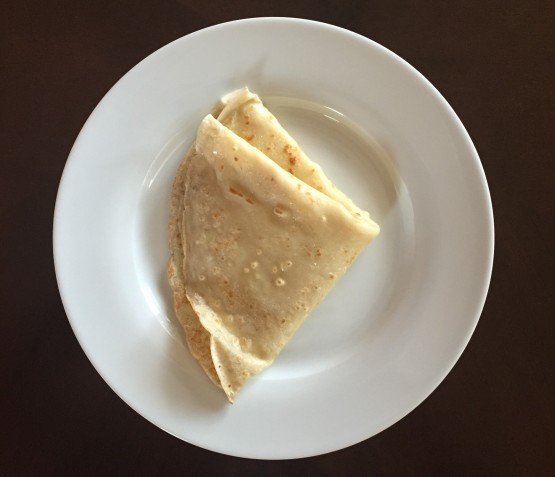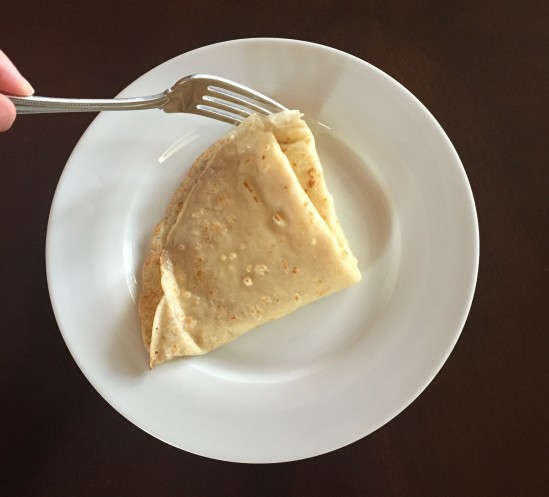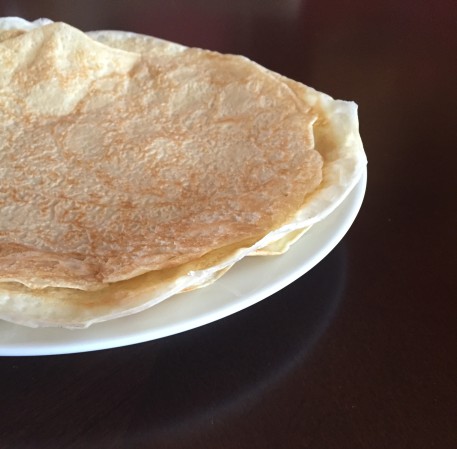
I personally have always been a little afraid of making crepes. I think it goes back to a disastrous blackened, smokey kitchen, burned-to-the-pan experience I had at around age 17 after returning from a trip to France. I had seen them easily whipped up into paper thin, warm, delicious vessels of all of the very yummiest things like cheese, chocolate, and oozy fruit compote. And I thought, I can totally do this.
It turns out that I can, but there are a few things that I needed to mess up first before learning how to make it work on the stovetop in a frying pan without that very cool little wooden sweeper rake thing that the French swish around the griddle to make perfectly even, thin crepes. First of all, recipes always seem to call for a medium high heat to cook these over and that burns my butter immediately and turns my crepes into something more like giant flour based potato chips, instead of velvety soft envelopes for treats. So I use medium heat, and am poised to turn it down a bit if I notice things going south. My crepes certainly do not come out perfect looking, but they are very tasty and easy to whip up.

For this morning’s breakfast (which, let’s face it, was really brunch because I didn’t really get rolling on making proper breakfast until around 11AM), I made crepes with a slice of swiss cheese thrown in and folded over on in the hot pan, and a pile of plain crepes that could be embellished however the person chowing down on them felt. There happened to be lemons and confectioner’s sugar already in the house, which is a classic flavoring for plain crepes and is absolutely delectable. This is a fun thing to make if you’re throwing a brunch, because it can be made much like a fancy, French, taco bar with a pile of crepes on a warm plate that you made ahead of time, and bowls of possible toppings ranging from sweet to savory (cheeses, fruit, nutella, maybe even smoked salmon??). Add in mimosas and you are officially a class act. (Or just actually serve tacos for brunch, that sounds like my kind of party 😉 )
The recipe below and here is adapted this recipe from Allrecipes.com, with a few slight changes and more notes on technique and details like how much butter to put in the pan, when to replenish to keep the crepes from sticking, but not drown them in butter, etc. Things that I learned the hard way, but you don’t have to!

{my crepe making audience}
Crepes
Ingredients:
2 eggs
1/2 cup milk
1/2 cup water
1 cup flour
1/4 teaspoon salt
2 tablespoons butter, melted and cooled
Method:
1. Whisk the eggs into the milk and water in a medium sized mixing bowl, preferably with a spout.
2. Sift in the flour, or fluff it with a fork before forking it into the liquids. Basically, you’re trying to minimize lumps here. Whisk it all together thoroughly until relatively lump free.
3. Whisk in salt and cooled melted butter (hot butter will cook the eggs).
4. Heat a standard frying pan to medium. Give the batter one last whisk and then drop a small pat of butter into the hot pan. Whirl the butter around to coat the entire bottom of the pan and up the sides. Make sure you’re thorough with the butter or these things will stick!
5. Pour about 1/4 cup of the batter into one side of the pan and immediately swirl around to coat the bottom. It’s ok if it’s a little lacy at the end of your swirl and doesn’t completely coat, the crepe will still taste good 🙂
6. Cook for about a minute of so. When you see the edges starting to curl away from the pan, take the opportunity to slip a thin spatula in there to take a peek and see if the bottom is lightly browned. If it is, flip the crepe. I do this by tilting the pan almost completely perpendicular to the stove and pulling the crepe almost completely out onto the spatula and then popping it back in with the uncooked side down. This works because the crepes aren’t as heavy as classic American pancakes.
7. Cook the opposite side for about a minute until lightly browned and then slide out onto a warm plate. If you are melting cheese into the crepe, put the cheese on top of it in the pan as soon as you flip it and melt for a minute before folding and then removing from the pan.
8. Add a new pat of butter only when you need it. You can do at least a few crepes in between each re-buttering of the pan. They’ll be greasy and drowning in butter if you add a fresh pat in between each crepe.

I’ll bet the crepes were delicious! I hope your furry friend got a taste…lol
LikeLike
Lol, she is a huge mooch
LikeLike